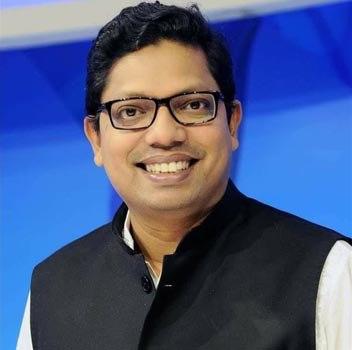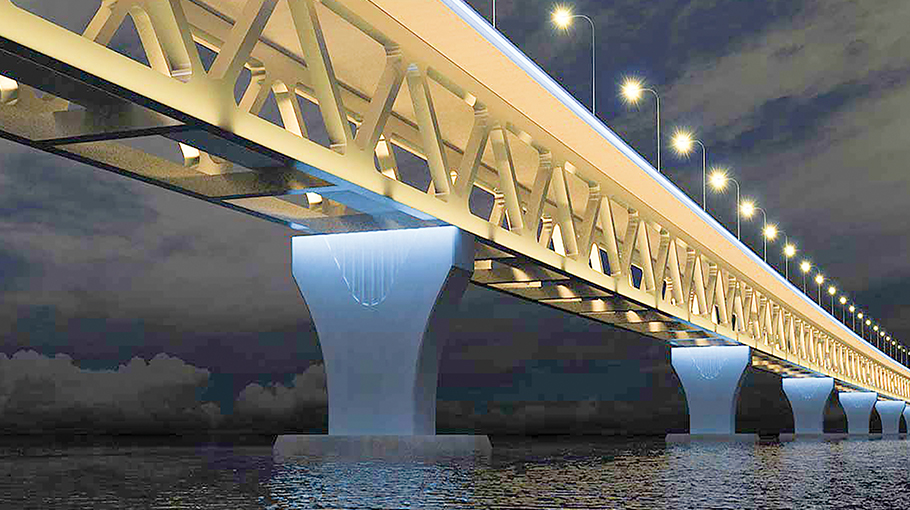Padma Bridge is the symbol of PM’s indomitable courage

Bangladesh was one of the 10 poorest countries in the world when Father of the Nation Bangabandhu Sheikh Mujibur Rahman took over the responsibilities of the war-torn country on January 12, 1972. The country’s 88 percent people were poor. Dependence on foreign aid was also 88 percent. Many expressed doubts whether Bangladesh would survive? US Security Adviser Henry Kissinger described Bangladesh as a ‘bottomless basket’.
The Bangabandhu started well-planned economic activities with empty hands standing on the rubble. In the second year of the first Five Year Plan (1973-78), the country’s GDP rose to 9.59 percent against the target of 5.5 percent in 1974-75, which is a record GDP till date. But after the assassination of the Bangabandhu on 15 August 1975, the country was plunged into darkness.
The military and semi-democratic rulers directly and indirectly shared power with the anti-independence forces and ruled the country for 21 long years. During their tenure, GDP growth had never been above 4 percent to 5 percent.
But what do we see if we take into account the tenure of Hon’ble Prime Minister Sheikh Hasina, the worthy successor of the Bangabandhu, from 1996-2001 and 2009 to the present? After the Bangabandhu, she has brought all fields, including economy and development, to the highest level in history. She has taken the country to a unique height.
The GDP growth was 7.25 percent in FY 2021-22, which was above 8 percent in FY 2018-19 before the Covid-19. Bangladesh is now the 41st largest economy in the world. The country is a wonder of development in the world.
This June 25 is going to be another milestone in the development journey of Bangladesh. On this day, the Prime Minister is going to inaugurate the Padma Bridge of her dream. It is not just a bridge. It is a bridge that is creating a history for a country which was 88 percent foreign aid dependent. On the other hand, it is a bridge to create examples of courage and honesty by tackling conspiracies and challenges. This article is about the construction of the Padma Bridge.
Hon’ble Prime Minister Sheikh Hasina is a visionary leader. The construction of a bridge over the Padma River is one of her long-cherished dreams. Because if the Padma Bridge is constructed, it will not only improve the economic condition of the people of 21 districts in the southwest part of the country, but will also make a huge contribution to the economy of Bangladesh. The bridge will play a huge role in all fields of agriculture, industry, economy, education and trade. An integrated communication system will be developed. It will connect the region with the Trans-Asian Highway and the Trans-Asian Railway. International connectivity with Bangladesh, India, Bhutan and Nepal will be established. The importance of the Mongla port will increase manifold. There will be expansion of industries, including tourism, in the southwest region. On both sides of the Padma Bridge, cities like Singapore and Shanghai will be built. A study by an independent consultant of the World Bank and a consultancy firm employed by the Bridge Division also projected the economic impact of the Padma Bridge. According to the survey, if the Padma Bridge is constructed, the GDP will increase by 1.23 percentage points. The southwestern GDP growth will increase by 2.3 percentage points.
When the Awami League won the 1996 national elections, a new government led by Prime Minister Sheikh Hasina began its journey. The Padma Bridge, the dream of the Prime Minister, is on the priority list in economic activities. The pre-feasibility study of the Padma Bridge was conducted in 1999. On July 4, 2001, Prime Minister Sheikh Hasina laid the foundation stone for the construction of the Padma Bridge.
Unfortunately, the implementation of the Padma Bridge project could not be started smoothly. Political vengeance, domestic and international conspiracies hampered the implementation of this bridge project. During the rule of the BNP-Jamaat alliance led by Begum Khaleda Zia, the pace of construction of Padma Bridge slowed down. After a detailed study, in 2004 JICA recommended the construction of the Padma Bridge at Mawa-Zajira point. But the BNP-Jamaat alliance government did not take any effective steps to move ahead with the implementation of the project. They did not pass the Padma Bridge project at the ECNEC meeting in light of the detailed survey. The reason for this was the laying of foundation stone by Sheikh Hasina. The Prime Minister was so interested in the construction of the Padma Bridge that she included the construction of the Padma Bridge in the form of a pledge in the election manifesto of the Awami League before the 2008 national elections. The people of the country are fortunate that the government was formed under the leadership of Sheikh Hasina on December 12, 2008 with a landslide victory in the national elections. She again took initiative to speed up its implementation by giving priority to the construction of the Padma Bridge.
It is sad but true that the Padma Bridge project with huge economic potential fell victim to domestic and foreign conspiracies. The World Bank repeatedly recommended a blacklisted company to hire as a consultant. The evaluation committee headed by Jamilur Reza Chowdhury, a distinguished professor at BUET, the country’s highest educational institution, did not agree to appoint that blacklisted company as a consultant. The appointment of consultants was delayed due to repeated recommendations of the World Bank. In 2011, the World Bank alleged that it had found a ‘credible’ corruption conspiracy in the Padma Bridge project, with high-ranking officials involved.
Prime Minister Sheikh Hasina took up the challenge and asked the World Bank to prove the allegations. The World Bank has filed a complaint against Canadian SNC-Lavalin with the Canadian Royal Mounted Police. A lawsuit was later filed in a Canadian court. Later, on June 29, 2012, the President of the World Bank, Robert Zoellick, canceled the loan for the Padma Bridge. The question is that when not a single penny was released for the implementation of the project, how corruption was committed?
Such questions are also being asked by the conscious community. In fact, there was a deep conspiracy behind it. The decision to cancel the loan was made not only by the World Bank but also by domestic and international stakeholders. Their aim was to tarnish the image of the Awami League government at home and abroad and help the opposition to ensure the defeat of the Awami League in the 2014 elections. The conspiracy was linked to opposition politicians and a number of civil society figures, including the Nobel laureate who wanted to oust Sheikh Hasina from politics during the 1/11.
The depth of the conspiracy will become clearer if we focus on the activities after the cancellation of the World Bank loan. The World Bank gave the government conditions one after another for the loan again. As per the advice of the World Bank, the government removed Syed Abul Hossain from the ministry of communications. Bridges Secretary Mosharraf Hossain Bhuiyan had to go to jail following his arrest demand. He also lost his job. Prime Minister’s Finance Adviser Md. Moshiur Rahman has to go on holiday. But despite all this, there has been no positive response from the World Bank on the loan.
It is noteworthy that the country’s leading opposition politician, Nobel Laureate and some members of the civil society were trying to prove the allegations of corruption raised by the World Bank in the Padma Bridge project. They also gave statements. There are allegations that the so-called Nobel laureate used an influential country so that the World Bank does not finance the project. The Prime Minister took a tough stance as she could have guessed the conspiracy.
She announced the construction of the Padma Bridge in July 2012 in the National Parliament with own funds. It was a timely and bold utterance, which was admired by all quarters at home and abroad. Following this, on January 31, 2013, Finance Minister AMA Muhith wrote two letters to the President of the World Bank and the ADB, JICA and IDB informing them that the government does not need their financing in the Padma Bridge project. Work on the Padma Bridge started in 2015 with Bangladesh’s own funds. In the midst of this construction, the Federal Court of Canada ruled that the World Bank’s allegations of corruption were false. The government surprised the world by the construction of the Padma Bridge with its own funds in seven years.
Many, including economists, observed that Bangladesh was going to be in big economic risk by going to construct the Padma Bridge with its own funds. But it did not happen. The truth is that the conspiracy has been foiled by the determination, courage and honesty of Prime Minister Sheikh Hasina. Bangladesh’s economic potential has been proven to the world. The image of the country has brightened. Therefore, the Padma Bridge is not just a bridge; it is a symbol of honesty and courage of the people’s leader Sheikh Hasina.
[The article is translated from Bangla]
- Zunaid Ahmed Palak, MP, Minister of State for Information and Communication Technology. He can be reached through e-mail: me@palak.net.bd




